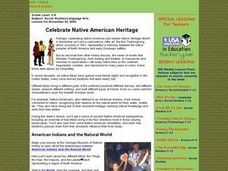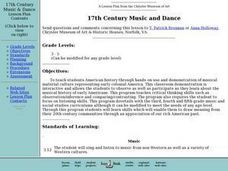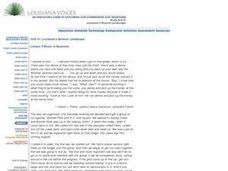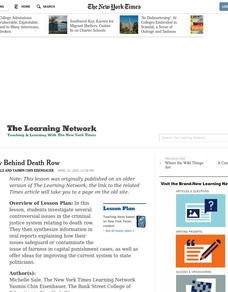Curated OER
FOOD FOR THE ANCESTORS
Students identify the foods associated with the "Days of the Dead Celebration." They compare and contrast these foods to the foods associated with American celebrations and become familiar with the foods of Mexico and their relationship...
Curated OER
Celebrate Native American Heritage
Students examine Native American heritage. They explore a museum of Native American culture and explore their food, dress, and customs. They also explore the Native Americans role in the first Thanksgiving.
Curated OER
Self Discipline: Building Character
There is not a clear purpose for this resource. It seems to be partly an exploration of self-discipline and a discussion of the myth The Dancing Horses of Sybaris. If a class was studying this myth, it could be altered, and corrected in...
Curated OER
1980's Quiz 2
In this 1980's quiz worksheet, students answer a set of 10 questions. An answer key and links to additional activities are given.
Curated OER
What Do You Bring To The Dance?
Students appreciate the contributions of every Province of Canada. They develop information links with fellow Canadians across the country. They focus on the dynamic interplay between the regions and the federal government.
Curated OER
17th Century Music and Dance
Students explore American history through hands-on use and demonstration of musical material culture representing early colonial America. They compare the music of colonial America to modern music.
Curated OER
Music Is Business
Students explore and assess the importance of music to the economy of Louisiana. They review and analyze the jobs, skills and careers found and needed in the state's music industry as well as how to meet and make personal contact with...
Curated OER
Forced Assimilation
Students identify ways that a society promotes assimilation and examine areas where it still occurs in our present culture. They assess the value of assimilation.
Curated OER
Harriet Tubman
Students sing the song "Harriet Tubman" by Walter Robinson. In this African-American history lesson, students review code words that were used during the slave trade and listen to the song "Harriet Tubman". Students create movements to...
Curated OER
Quilting
Second graders make a quilt. In this cultural diversity lesson, 2nd graders review their knowledge of the Metis people. Students work in groups to create a class quilt that illustrates the lives of these people. Quilt themes include...
Curated OER
The Row Behind Death Row
Students investigate several controversial issues in the criminal justice system relating to death row and give oral reports explaining how their issues safeguard or contaminate the issue of fairness in capital punishment. They offer...
Curated OER
What's Behind that Mask?
Students use a "spider web" graphic organizer to record information about different types of masks they are familiar with. They write a paragraph about masks. Students read about Native American cultures and compare/contrast the...
Curated OER
Art Through the Eyes of Youth
Students take a field trip to an art gallery reflecting on the paintings they like the most. Individually, they use magazines to find pictures related to their personality. In pairs, they make a mask to represent their ethnic group and...
Curated OER
The Four Corners Region of the United States Cultures, Ruins and Landmarks
Learners who live in the inner city are introduced to the four corners region of the United States. In groups, they examine how the region differs compared to where they live and their culture. They develop maps of the area and locate...
Curated OER
Cinco de Mayo
Students investigate the Cinco de Mayo holiday. They discuss the history of Cinco de Mayo, listen to the Legend of the Mexican flag, color a worksheet of the Mexican flag, and create a class coat of arms.
Curated OER
Art to Zoo: India-Where Remarkable Differences Are Ordinary
Students "visit" India to learn about its culture and the lives of children in India. In this India instructional activity, students conduct research and report on the lives of Indian children in the form of a mock interview between a...
Curated OER
Getting to Know You
Students participate in tactile and visual exploration. In this tactile and visual exploration lesson, students listen to John Archambault's, Grandmother's Garden, and sing the song, "Friends Are Like Flowers." They participate in ice...
Curated OER
Ways we are Alike/ Ways we are Different
Students complete a chart comparing and contrasting African villages with their own communities. The lesson focuses on the Mbuti and Fulani people. They explore their style of living, their traditions and everyday life in these villages.
Curated OER
Patriotism and Foreign Policy
Twelfth graders create a museum of Patriotism and Foreign Policy. They participate in discussions and work in committee's to determine which objects shall be displayed in the museum. They present visual and performing arts along with...
Curated OER
Africa: The Middle Passage and 19th Century America
Students participate in a series of activities to explore the lives of slaves in 19th century America. They examine the design of slave ships, the hardships endured, and the ways that owners depended on slaves for their economic survival.
Curated OER
All Those In Favor
Young scholars share opinions about measures recently passed in their school, vote on and argue for and against hypothetical school policies, and respond to a "president's" decision to pass or veto the measures.
Curated OER
The Blackfeet of Glacier National Park
Learners research an aspect of the Blackfeet tribe in Glacier National Park. They work together to create a presentation that is representative of their culture. They share their presentation with the class.
Curated OER
What's your favourite film?
Students poll other students on their favorite films today and of all time. A rubric is devised to tally the results. The results are shared with the class. In the end, Students taking the poll vote themselves.
Curated OER
Giving Human Rights a Human Face
Students produce a creative expression of an article of the Universal Declaration of Human Rights. They may also create posters to serve as reminders for creating a human rights environment or community.

























